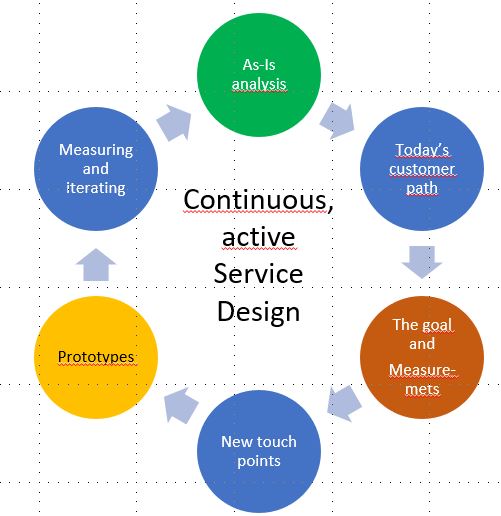I have previously written about the development of processes: developing processes either as a continuous process (POOGI) or making giant leaps is a great opportunity, but also quite challenging. The company’s own resources may be so tied up in daily operational activities that there is no time for specific development project.
Using consultants in development brings resources and know-how into the company. However without sufficient input from own staff, the know-how and experience will not remain the company’s know-how capital.
Service design may be the answer to this problem. Service design aims to combine the methods used in product design with the development of operations – innovating together and experimenting with different options. Service formatting tasks can be presented in the form of a circle below:

Service design is a more informal way to approach the customer process (than strict processing modelling and development). Its advantages over traditional process development are:
- lighter – less quantitative modelling,
- concrete – let’s immediately go to customer needs and understand it,
- quick – results are obtained quickly (as long as new policies are invented),
- flexible – different options can be tested and their functionality can be verifyed,
- transparency – employees are constantly involved and learn new working methods,
- continuity – work is continuous and not project-like.
Problems with service design can be seen as:
- the holistic view may become blurred – focus is on local optimizations,
- making changes that are too hasty and poorly prepared,
- management becomes ‘nervous’ – constant changes (unless there is good leadership for this),
- there are no metrics to verify the change.
In practice, in service design, the service (product) is divided into parts that can be developed as parts of the whole by iterating and experimenting. The aim is to understand how the customer perceives the company’s services and products.
The service is modeled in a visually easy-to-understand format. This enables employees, suppliers or customers to be involved in development work with a little orientation.
Some time ago, we carried out an analysis of the customer interfaces of a company. The result was surprising: a total of 23 different contact points were identified. The original assumption was that the customer would be met in sales; however, a large part of the customer communication was in fact in logistics, product management and partly in financial management.
Step-by-step development reduces the risk of managing change while quickly delivering results. At the same time, all the company’s expertise and experience in customer work can be helped with the development.

